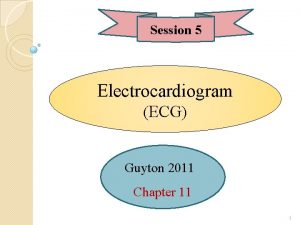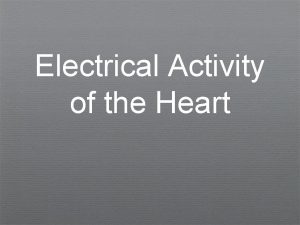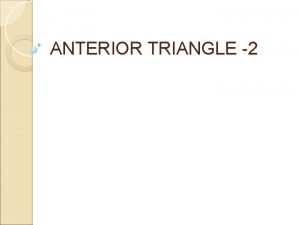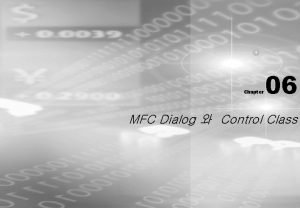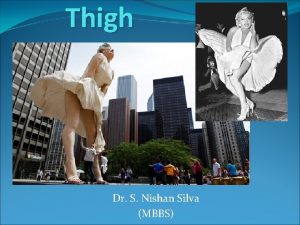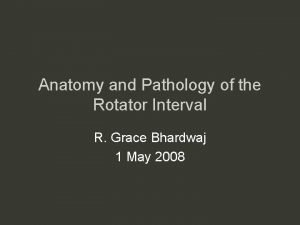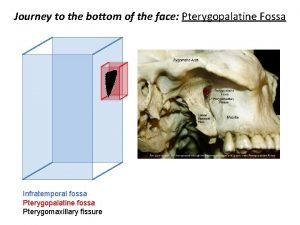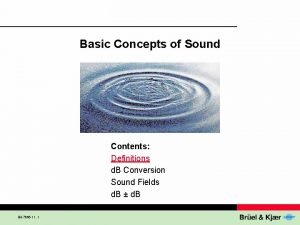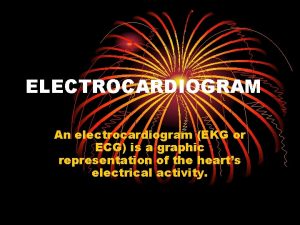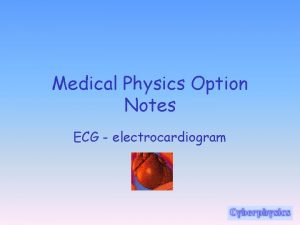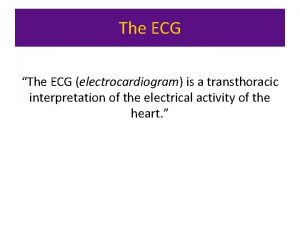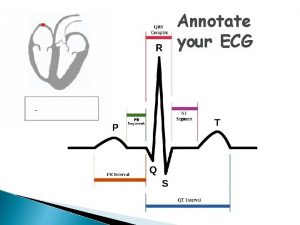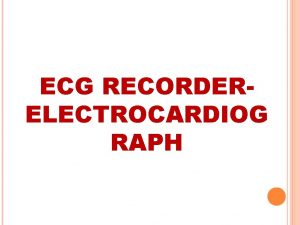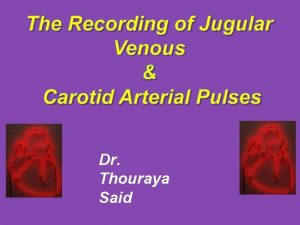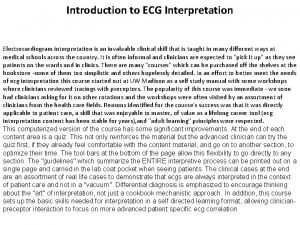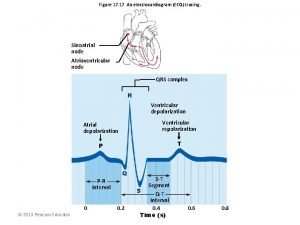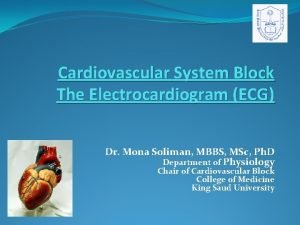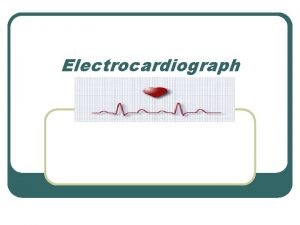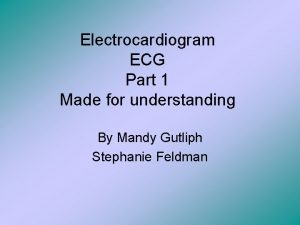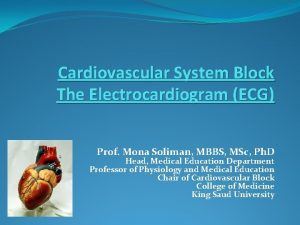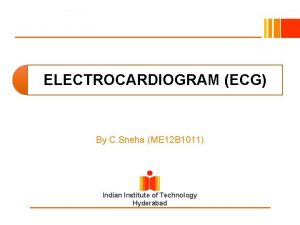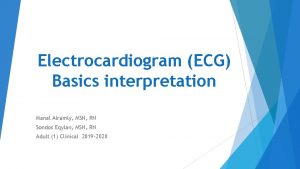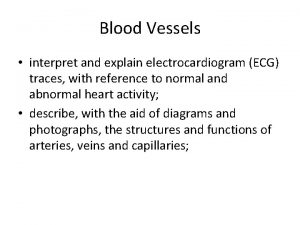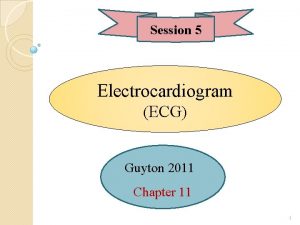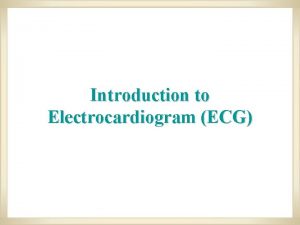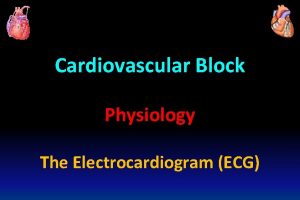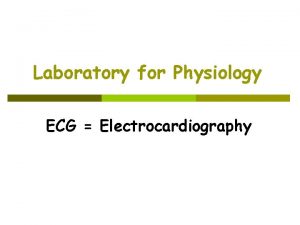Electrocardiogram Dr Thouraya Said Contents 1 ECG paper





































- Slides: 37

Electrocardiogram Dr. Thouraya Said

Contents 1. ECG paper. 2. ECG leads: Limb leads. Chest leads. 3. Interpretation of the ECG. 4. Cardiac axis 5. Heart rhythm. 6. Heart rate.

• ECG records the electrical changes (depolarization and repolarization) that take place in the heart/per cycle. • These changes can be detected by electrodes attached to the surface of the body. • Subject supine, relaxed. • Temperature of the room : neutral.

ECG Paper • The ECG is recorded on a graphic paper with standardsized squares. • The horizontal axis: time measured in seconds. 1 small square (1 mm): 0. 04 seconds 1 large square: 0. 20 seconds. 5 large squares: 1 second. • The vertical axis: changes of voltage. 10 mm = 1 cm = 1 millivolt. A signal of 1(m. V) should move the stylus vertically 1 cm (2 large squares). • The standard paper speed is 25 mm/sec.

ECG Paper

The 12 standard ECG leads • A lead is formed by a pair of electrodes. • Frontal Plane ( 6 limb leads) Bipolar Leads: I , II , and III Unipolar leads: a. VR, a. VL, a. VF • Transverse Plane: Unipolar chest leads: V 1 to V 6

3 bipolar limb leads: I, III • Record the difference in potential between 2 limbs. • ECG was first recorded by placing electrodes on 3 places: Right and Left arms and Left leg • (Recording +ve Ede) (-ve reference Ede) • Depolarization moving towards a +ve Ede produces a +ve deflection. • Depolarization moving in the opposite direction produces a –ve deflection.

• Lead I: Left arm Ede is +ve, the other is –ve. • Lead II: Edes on the right arm and the left leg with the leg +ve. • Lead III: Ede of the left arm is –ve, Ede of the left leg is +ve. • The 3 leads arranged as a triangle are known as Einthoven’s triangle.

I II III

Formation of the triaxial system & assignment of degrees to leads I, III • By bringing the sides of the triangle to the common center. • The axes are 60° apart. • Axis of a lead: direction from the negative to the positive electrode • Lead I (+) is at 0° • Lead II (+) is at +60° • Lead III (+) is at +120°

Augmented unipolar limb leads a. VR, a. VL, and a. VF Are recordings between 1 limb and the other 2 limbs. • a. VR (augmented, Voltage, Right arm +ve) • a. VL: uses left arm as +ve. • a. VF: uses left leg as +ve.

• Leads a. VR, a. VL, a. VF cross at # angles and produce an intersection of 3 other lines. • Angles of 60° like for lead I, III. a. VR-150° a. VL-30° a. VF+90

Formation of hexaxial system • Leads a. VR, a. VF, a. VL divide the angles formed by lead I, III. • The leads cross precisely at 30°.

B: 6 standard “chest leads” depict electrical events in the horizontal plan e. • One +ve Ede is placed on 6 different positions around the chest. • The reference –ve Ede is a combined limb lead.

Chest leads: • V 1 – Right sternal border, 4 th ICS. • V 2 – Left sternal border, 4 th ICS. • V 3 – Halfway between leads V 2 & V 4. • V 4 – Left mid- clavicular line, 5 th ICS. • V 5 – Anterior axillary line, 5 th ICS. • V 6 – Mid axillary line, 5 th ICS.


The standard 12 -lead ECG �How many electrodes? 10 electrodes �How many leads? 12 leads

The 12 -lead ECG

Interpretation of the normal ECG • • Atrial activation: The impulse originates at SA node, spreads through the atria. This causes positive upward deflection. The P wave represents the depolarization of both atria. Pw: <0. 12 sec < 2. 5 mm

Septal Activation: • The impulse spreads to the AV node, common bundle of His and R and L bundle branches then enters the IV septum. • This occurs during PR segment.

• PR interval: P wave + PR segment. • Time of transmission of electrical impulse from the beginning of atrial depolarization to the beginning of ventricular depolarization. • PR: 0. 12 - 0. 20 seconds (less than 1 large square). • PR prolonged > 0. 20 seconds. First degree heart block. • PR shortens as heart rate increases.


Ventricular depolarization • The wave of depolarization spreads in the Purkinje fibers to all parts of the ventricles. • The initial negative deflection is Q wave. • The first positive deflection is R wave. • The negative deflection after R wave is : S wave. • QRS duration: < 0. 10 sec.

Ventricular repolarization: T wave • Ventricular repolarization represented by ST segment and T wave. • ST segment: period between the end of QRS and the start of T wave. • QT interval: from beginning of Q wave to end of T wave (ventricular dep and rep) < 0. 43 sec. • ST interval: QT-QRS = 0. 32 sec.

ECG intervals Normal Duration(s) Events in the Heart During Interval Average Range PR interval Pw + PR segment. 0. 18 0. 12 -0. 20 < 1 large square Atrial depolarization and conduction through AV node QRS duration 0. 08 To 0. 10 Ventricular depolarization and atrial repolarization QT interval 0. 40 To 0. 43 Ventricular depolarization plus ventricular repolarization ST interval (QT minus QRS) 0. 32 … Intervals Ventricular repolarization

Examples of ECG abnormalities • Prominent U wave: hypokalaemia. • Tall T wave: hyperkalaemia. • Short QT interval: hypercalcaemia. • Prolonged QT interval: hypocalcaemia. • ST elevation, T inversion, large Q wave: myocardial infarction.

Cardiac axis • The mean QRS vector is the preponderant direction of the potential during depolarization. • The mean electrical axis of the ventricles is 59°.



Normal Axis: from -30 ° to +90 ° Left Axis Deviation: Obese (normal) LV hypertrophy LBBB from -30 ° to -90 ° Right Axis Deviation: Thin tall (normal) R V hypertrophy RBBB Extreme Right Axis Deviation: from + 90° to ± 180 ° from -90 ° to ± 180°

Inspection method RIGHT AXIS DEVIATION


Rythm Sinus rhythm: P wave before every QRS: Impulse from SA node Sinus Regular : distance between R-R: constant R R Irregular : Unequal R-R intervals

Rythm Sinus arrythmia (normal physiological phenomenon) Deep inspiration : Rwaves closer : fast rate Deep expiration: bradycardia

Heart rate Examine the distance between QRS complexes. If the distances are regular, use one of these two formulas: 300 Big squares between R-R Or: 1500 Small squares between R-R To obtain the heart rate in beats per minute.

1 complex every 1 major division = 300/min 1 complex every 2 major divisions = 150/min 1 complex every 3 major divisions = 100/min 1 complex every 4 major divisions = 75/min 1 complex every 5 major divisions = 60/min 1 complex every 6 major divisions = 50/min

 Electrocardiogram
Electrocardiogram Thouraya abdellatif
Thouraya abdellatif Thouraya abdellatif
Thouraya abdellatif Think said the robin
Think said the robin Ecg big box
Ecg big box Aice english paper 2
Aice english paper 2 Aice general paper prompts
Aice general paper prompts Carotid sheath contents
Carotid sheath contents Crm strategy example
Crm strategy example Contents training clovis
Contents training clovis Science table of contents
Science table of contents Electronic table of contents
Electronic table of contents Class contents
Class contents Epq exemplars
Epq exemplars Contents of curriculum vitae
Contents of curriculum vitae Ip contents
Ip contents Contents of a dead man's pocket conflict
Contents of a dead man's pocket conflict Popliteal fossa contents
Popliteal fossa contents External conflict in contents of the dead man's pocket
External conflict in contents of the dead man's pocket Spermatic cord
Spermatic cord Module 3 ctd table contents
Module 3 ctd table contents Cdmvt
Cdmvt Report appendix example
Report appendix example Pretracheal fascia
Pretracheal fascia Cell contents assignment to a non-cell array object.
Cell contents assignment to a non-cell array object. Science fair logbook example
Science fair logbook example Intermediate cutaneous nerve of the thigh
Intermediate cutaneous nerve of the thigh Ark
Ark Nature table of contents
Nature table of contents Rotator cuff interval
Rotator cuff interval Prehn's sign
Prehn's sign Contents of a marketing plan
Contents of a marketing plan Content page magazine
Content page magazine Pterygopalatine fossa boundaries
Pterygopalatine fossa boundaries Oxygen table of contents
Oxygen table of contents Mediastinum
Mediastinum Sound pressure
Sound pressure Contents background
Contents background
